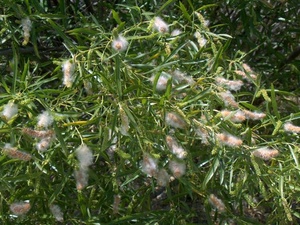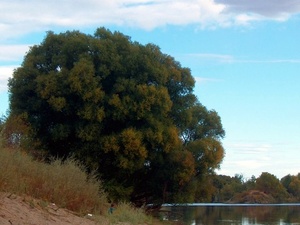 A female Narrowleaf Willow (Salix exigua) with fluffy seeds. Photo by queerbychoice.Willows are winter-deciduous trees or large shrubs in the Salix genus of the willow family (Salicaceae) that usually grow in wetlands. Other members of the willow family include Cottonwood Trees and Brushholly.
A female Narrowleaf Willow (Salix exigua) with fluffy seeds. Photo by queerbychoice.Willows are winter-deciduous trees or large shrubs in the Salix genus of the willow family (Salicaceae) that usually grow in wetlands. Other members of the willow family include Cottonwood Trees and Brushholly.
Willows are host plants for the caterpillars of the Lorquin's admiral, mourning cloak, Western tiger swallowtail, and green comma butterflies. In addition, native birds such as lesser goldfinches, acorn woodpeckers, and white-crowned sparrows frequently use willows for food or shelter.
Willow trees are either male or female. The male trees produce pollen and cause hay fever. The female trees produce fluffy seeds. Willows typically bloom from about January through June, so if you suffer from hay fever during those months and live near a male willow tree, the tree could be the culprit. Check the hay fever page for what to do if male trees are impairing your health.
Native to Woodland
Six willow species are native to Woodland, and these are the only six willow species that are native anywhere in Yolo County.
Narrowleaf Willow (Salix exigua) is a 10- to 20-foot-tall tree or large shrub that is native throughout Woodland. It prefers full sun and usually grows in wetlands. The pollen of this species is considered a severe allergen.
 San Joaquin Black Willow (Salix gooddingii) on the bank of the Feather River. Photo by queerbychoice.San Joaquin Black Willow (Salix gooddingii) is a 40-foot-tall by 30-foot wide tree that is native throughout Woodland. It prefers full sun and usually grows in wetlands. The pollen of this species is considered a severe allergen.
San Joaquin Black Willow (Salix gooddingii) on the bank of the Feather River. Photo by queerbychoice.San Joaquin Black Willow (Salix gooddingii) is a 40-foot-tall by 30-foot wide tree that is native throughout Woodland. It prefers full sun and usually grows in wetlands. The pollen of this species is considered a severe allergen.
Polished Willow (Salix laevigata) is a 50-foot tall by 50-foot-wide tree that is native throughout Woodland. It prefers full sun or partial shade and usually grows in wetlands. The pollen of this species is considered a severe allergen.
Shining Willow (Salix lasiandra) is a 20- to 30-foot-tall shrub or small tree that is native throughout Woodland. It prefers partial shade and usually grows in wetlands.
Arroyo Willow (Salix lasiolepis) is a 35-foot-tall by 15-foot-wide tree or large shrub that is native throughout Woodland. It prefers full sun and usually grows in wetlands. The pollen of this species is considered a severe allergen.
Dusky Willow (Salix melanopsis) is a 7- to 13-foot-tall tree or large shrub that is native throughout Woodland. It prefers partial shade and grows only in wetlands.
Non-Native
Weeping Willow (Salix babylonica) a fast-growing deciduous tree from China. It usually grows about 60 to 80 feet tall and lives about 40 to 75 years. Only the male trees produce pollen, but the male trees are ranked 10 out of 10 on the Ogren Plant Allergy Scale, indicating that they tend to cause very severe allergic reactions. Weeping Willow is planted in Grace Hiddleson Park, Pioneer Park, and Ralph Harris Park.


